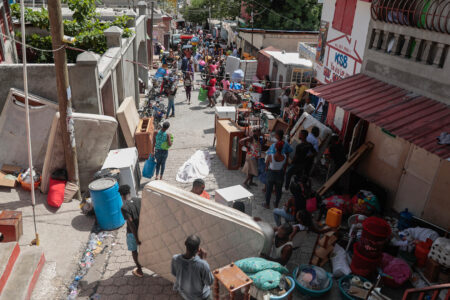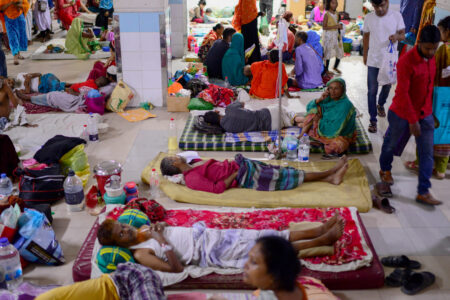
Many commentators and political leaders here and abroad have expressed the view that since the United Nations Security Council has not enacted a fresh resolution authorizing the invasion of Iraq, the countries attacking Iraq were breaching international law by doing so. Indeed, some people, including Canadian parlia- mentarians, have argued that the leaders of those countries, notably US President George W. Bush and British Prime Minister Tony Blair, are war criminals.
The question of when it is appropriate for one sovereign nation to use force against another can be debated almost without end. Nevertheless, the narrower question of whether the Security Council has authorized this war is easier to answer. When the relevant sections of the Charter of the United Nations and the relevant Security Council resolutions are examined, it is clear that the Security Council has authorized this war. One of the problems with Security Council res- olutions, however, is that they are written in a form of international legalese, using the vaguest of nouns and verbs to describe an authorization for war. Therefore, in order to understand why the Security Council’s resolutions authorize this war, it is best to start with the Charter of the United Nations under which these resolutions have been passed to see what they must say in order to constitute an authoriza- tion for war. Then one can turn to the practice of the Security Council to see what it does when it authorizes war.
The UN Charter authorizes the use of force in Chapter VII. This chapter permits war in two circumstances. One cir- cumstance is individual or collective self-defence pursuant to Article 51. Countries that are attacked have the inherent right to defend themselves by war. The other circumstance is when the Security Council declares war on behalf of the international community.
Now, Chapter VII doesn’t actually use the word ”œwar” or describe a resolu- tion pursuant to this chapter as a ”œdec- laration of war.” The Charter is a bit more circumspect than that, and gets to war in a roundabout sort of way starting with a ”œdetermination” under Article 39, the first article of Chapter VII.
Under Article 39 the Security Council may ”œdetermine the existence of any threat to the peace, breach of the peace or act of aggression.” Article 39 is very broadly worded. The article gives the Security Council the power to decide (”œdetermine”) that a threat short of an actual breach of peace and security exists, that a breach of peace and secu- rity short of an act of aggression exists, that an act of aggression short of an attack on another country exists, or that an actual attack has taken place. Obviously in the last case the country that is the object of the attack has the right to defend itself by force independ- ent of any Security Council determina- tion under Article 39.
Interestingly, Article 39 does not require that the threat to or breach of the peace must have been committed by a sovereign nation. Although it is doubtful that the framers of the UN Charter had in mind state-sponsored terrorists when they drafted the lan- guage of the Charter, Article 39 is writ- ten in language that is broad enough to encompass threats or breaches to the peace by states that sponsor terror- ists but that otherwise do not overtly threaten any other country.
The Security Council does not have a lot of practice declaring war. It has done so only twice. The first time was in 1950 when North Korea invad- ed the Republic of Korea, and the sec- ond time was forty years later when Iraq invaded Kuwait. Therefore, in order to figure out what the Security Council must say in order to author- ize war and what it does to wage the war, the best places to look are in its resolutions authorizing the Korean and Gulf wars.
The Korean war was conducted essentially under three resolutions, Resolutions 82, 83 and 84, which were enacted in June and July 1950. In these resolutions the Security Council ”œdetermined” that North Korea’s attack on the Republic of Korea consti- tuted a breach of the peace. The Council then ”œcalled” upon the mem- ber states to provide assistance in enforcing these resolutions and ”œrec- ommended” that the member states assist the Republic of Korea in restor- ing international peace and security to the area. Importantly, the Security Council recommended that those countries wishing to provide military assistance do so under the command of the United States of America. Although these resolutions did not expressly refer to Chapter VII or any article of that chap- ter, it is clear from the language of the resolutions that they were enacted under that chap- ter. The ”œdetermination” was obviously made pursuant to Article 39, and the ”œcalling” on all other countries to restore international peace and securi- ty was obviously an ”œaction” under Article 42.
After Iraq invaded Kuwait in 1990, the Security Council did not at first authorize war, although Kuwait, of course, had the right to defend itself. Rather, the Security Council passed Resolution 660 under Articles 39 and 40 of Chapter VII in which the Council ”œdetermined” that, as regards the Iraqi invasion of Kuwait, there existed a breach of international peace and secu- rity. This determination, which has been recalled in all subsequent resolu- tions, permitted the Security Council to decide what should be done about Iraq in order to restore international peace and security.
What the Security Council decid- ed to do is pass Resolution 678. In this resolution the Security Council demanded that Iraq fully comply with Resolution 660 and all subsequent res- olutions that it breached. The Security Council gave Iraq until January 15, 1991 to comply with these resolutions. If Iraq did not do so, Resolution 678 authorized the member states ”œto use all necessary means” to ”œrestore” inter- national peace and security and ensure compliance with the resolutions Iraq had breached. Using all necessary means is obviously an ”œaction” under Article 42. The Security Council also requested in this resolution that the member states provide appropriate support for the ”œactions” to restore international peace and security in the area. Unlike the Korean war resolu- tions, Resolution 678 was expressly enacted under Chapter VII of the Charter in its entirety. Resolution 678 was unambiguously a declaration of war, albeit a conditional one.
Of course, the UN does not possess its own military forces, and therefore it cannot itself wage war. Long before the second President Bush coined the phrase ”œcoalition of the willing” the Security Council adopted the concept. When the Security Council declares war, it requests and authorizes a ”œcoali- tion of the willing” to fight and per- mits that coalition to determine the tactics and strategy of the war as well as its aims. Therefore, after it declared war both against North Korea and against Iraq, the Security Council left it to the nations going to war to figure out how to conduct the war and how to restore ”œpeace and security.” In both cases it gave the United States of America conduct of that war.
After North Korea was ejected from South Korean territory, the Security Council enacted a resolution removing the complaint of aggression that had given legal sanction to the war from the list of matters of which the Council was then seized. In effect, the Council said that North Korea’s breach of the peace is now off its plate. However, when the first Gulf war ended the Security Council did the opposite. It enacted a ceasefire resolution and expressly resolved that the legal basis for the war remains until the terms of the ceasefire are complied with, which of course they never were.
The terms of the ceasefire are found in Resolutions 686 and 687. These resolutions, like all the other resolutions relating to Iraq’s invasion of Kuwait, were enacted under Chapter VII of the Charter in its entirety, including the articles authoriz- ing the use of force. Resolution 686 notes that combat opera- tions by the coalition forces had been ”œsuspended”, not that the authority for these operations had been set aside. Resolution 687, which enact- ed the formal terms of the ceasefire, ordered Iraq unconditionally to destroy all its chemical, biological and nuclear weapons and not to acquire new ones or the means of making new ones, among other things. It is clear from the terms of Resolutions 686 and 687 that if Iraq breaches the ceasefire, the war can lawfully resume as if hostilities had never ceased in 1991. Indeed, the con- trary cannot logically be argued.
As we all know, Iraq breached the terms of the ceasefire and subsequent resolutions. In response to some of its more flagrant breaches, such as eject- ing the weapons’ inspectors in 1998, America and Britain bombed Iraq’s military and security infrastructure. Nevertheless, over time the Security Council ignored Iraq’s noncompliance with the terms of the ceasefire. However, in November 2002 the Security Council enacted Resolution 1441. This is the resolution that contains the phrase ”œserious conse- quences.” It was not necessary to enact this resolution before resuming the war against Iraq. Over a dozen other resolutions enacted under Chapter VII, stretching back to the ceasefire resolu- tions, reaffirmed the right to wage war by ”œrecalling” the earlier resolutions that had authorized the first Gulf war. Resolution 1441 was enacted to reme- dy the Security Council’s nonaction over Iraq’s noncompliance with the Security Council’s resolutions going back to the ceasefire in 1991. In effect, the Security Council wanted to ensure that no one could argue that the legal effect of its previous resolutions had lapsed through lack of deliberate action to enforce them.
For this reason, in Resolution 1441 the Security Council simply reaffirmed that the legal basis for its declaration of war remains in effect. It did so by expressly recognizing under Chapter VII that Iraq’s noncompliance with the previous resolutions poses a ”œthreat to international peace and security.” It specifically recalled that the ceasefire declared in Resolution 687 depended on Iraq’s compliance with the terms of the ceasefire resolution and ”œdecides” that Iraq remains in breach of these terms. The Security Council then gave Iraq a ”œfinal” oppor- tunity to comply. Just to be sure that no one missed the point, at the end of all of this the Security Council reiterated that Iraq would face ”œserious conse- quences” as a result of its continued violations of its obligations. Serious consequences is, of course, an ”œaction.” In other words, in Resolution 1441 the Security Council expressly reaffirmed the language that is their code for war and reaffirmed the right to resume the war should Iraq not immediately com- ply with its obligations. Short of saying ”œany country that wishes to do so may attack Iraq again if it does not immedi- ately comply with the earlier resolu- tions,” the meaning of Resolution 1441 could not be clearer.
Indeed, the US and Great Britain have been using force against Iraq for over a decade without opposition from those countries on the Security Council that tried to prevent American action over the past few months. Those countries accepted that the use of force over this period was author- ized by the same Security Council res- olutions they now say do not authorize the present use of force. This is a very odd position for these states to take. The use of force against a sov- ereign nation, such as Iraq, is illegal unless supported by international law, after all. This would include years of bombing targets in Iraq.
The whole point of using force under the Charter of the United Nations is to change the behaviour of a state. The only limit on the degree of force to be used under Article 42 is that the force must be ”œnecessary” to maintain or restore international peace and security. Sometimes the force necessary to do so will consist of limited bombing or the like. Often, though, it will be necessary to invade a hostile state’s territory and remove its political and military lead- ership. Neither the Korean war resolutions nor the Gulf war resolution defined how much force was necessary to restore international peace and securi- ty. That was a matter for those countries using force under Chapter VII themselves to decide upon, as must be the case. In both wars, the coalition forces, not the Security Council, made this deci- sion. The same goes for the war against Iraq.
Accordingly, the position of the US, Great Britain, Australia and their allies that Iraq’s material breaches of the terms of ceasefire resolutions and others gave them the necessary legal authority to resume hostilities against Iraq for the purpose of changing the regime, was correct. Indeed, the legal basis for this war is much sounder than the legal basis for the military action against Serbia over Kosovo, which of course was not supported by any Security Council resolution before the battle was joined under the auspices of NATO. Short of Iraq’s invading a neighbouring country again, the legal justification for this war could not be more straightforward. Therefore, the debate over this war should stay where it belongs: in the arena of politics, not that of law.







